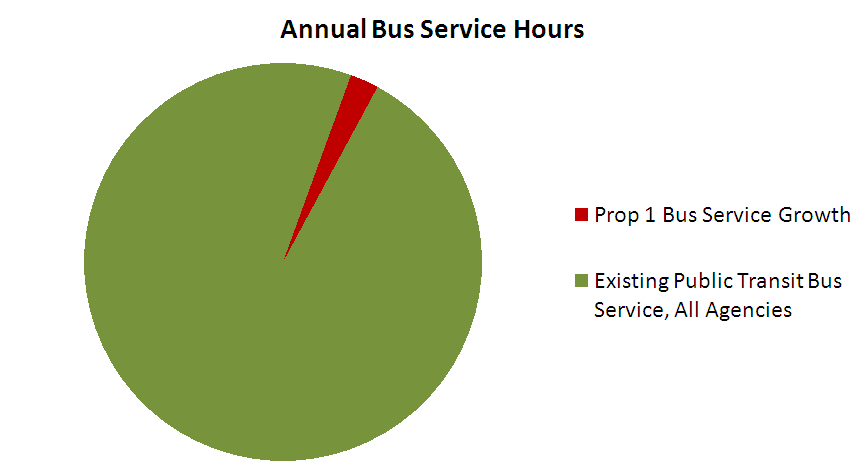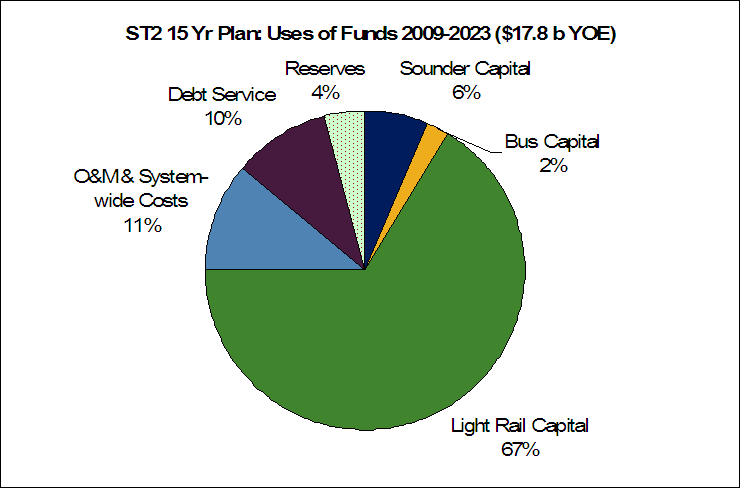![]()
![]()
![]()
Overcrowded buses are seen everywhere in the central Puget Sound region in 2008. The front page story in The Seattle Times of September 7 is headlined "Buses overflow, squeezing riders and transit in King, Snohomish counties."
Prop 1, if it passes, will do very little to improve the situation.
All of Sound Transit's existing bus service now amounts to about 10% of the total fixed route service in the region. Any increase resulting from passage of Prop 1 would be limited to expansion of Sound Transit's service, and not expand the bus services offered by King County Metro, Community Transit in Snohomish County, Everett Transit, and Pierce Transit.
As of late summer 2008, the sales pitch from the Mass Transit Now campaign for the bus expansion portion of the Proposition 1 15-year mass transit construction plan and associated 1/2 cent sales tax increase on the November 4, 2008 general election ballot goes like this:
"Proposition 1 is a smart plan that delivers an immediate 17% increase in express bus service across all three counties and up to 30% on the highest-demand routes, plus more Tacoma-Seattle Sounder trains."
Sound Transit Regional Express bus service is the limited-stop service that runs between the urban centers of different jurisdictions. These buses have a higher fare than charged by King County Metro and the other county-level bus systems.
The Prop 1 money only goes to Sound Transit, not the county bus agencies that provide 90% of bus service in the region, including many inter-community runs similar to Sound Transit bus routes.
If ST adds 17% to its own service hours quickly because of Prop 1, that would cover its most recent one year surge of rider growth, depending on where the buses are deployed vis a vis the corridors where there is passenger demand.
The Seattle Times article cited above reported these year over year growth rates on selected Sound Transit express bus routes:
Route 550 (Bellevue-Mercer Island-Seattle): 12%
Route 522 (Bothell-Lake City-Seattle): 18%
Route 545 (Seattle-Overlake-Redmond): 20%
Route 535 (Lynnwood-Bellevue): 42%
Year-over-year ridership growth on all ST's buses collectively is lately touted as 14%, and at King County Metro annual growth is in the 7% range. Other local agencies are seeing similar growth. Many individual runs are seeing much more than the average, as seen in the examples above.
Sound Transit putting 30% more service on high demand routes amounts to a supply surge for selected routes. Which routes will get the growth is a critical question if you are standing on a crowded ST bus during your daily commute.
In any event, the ST-promised 17% short-term surge represents about 25 more ST buses in service during peak periods. ST now operates a fleet of 228 buses.
Put another way, Mass Transit
Now also reports that 100,000 new revenue hours of annual bus service will be
added starting 2009. Revenue hours means the time the buses are in operation
with passengers aboard and not the total hours that buses are on the road
including layovers and empty dead heading.
It's important to have some perspective on what 100,000 more annual bus
service revenue hours signifies -- namely, it's a small number compared to the
immediate transit demands of the region, and a trivially insignificant
fraction of the Sound Transit Prop 1 Do-Over.
This many revenue hours over 15 years would be about a 2% one-time growth in
the total transit bus service across all the four local public transit
agencies in the three-county ST tax district, which collectively provide
around 4.3 million hours annually now. The following graphic puts these
numbers into perspective:

ST currently operates its buses
at a cost of about $150 per revenue hour, so 100,000 annual hours translates
to $15 million per year. Multiply $15 million by the 15 years of the ST2
construction program yields $225 million bus operating expense, leaving out
inflation.
On ST's proposed $17.9 billion program, this many millions for additional bus
service is rounding error, minor spillage, hair on the pig's tail, or similar
descriptive language. As a percentage, 225 million out of $17.9 billion is
about one percent.
The ST Board's amendment on July 24th to add more immediate bus service barely
moved the total package dollar number. The big money in Prop 1 is for light
rail later, not buses now.
The new Proposition 1 devotes
73% of its $17.9 billion in new spending over 15 years to extending light rail
tracks and adding more Sounder Commuter Rail service. Bus purchases and
new facilities for the Regional
Express Bus program gets 2%. (The 1% for additional bus service hours
calculated above is included in the 11% for Operating and Maintenance.) The remaining 25% of this new spending is
programmed for debt service, operations, maintenance, and reserves, as
follows in a graphic from Sound Transit's presentation to the Expert Review
Panel on July 21, 2008:

Most of the funding comes from the new 1/2 cent sales tax. The second biggest source is borrowing via sale of 30-year bonds, the interest on which beyond 15 years will add another $5 billion to the cost over the claimed $17.9 billion basic cost. The new taxes that are part of the plan have no firm sunset date. Furthermore, the Board's plan continues the Sound Move taxes -- now collected at the rate of one million dollars per day -- indefinitely, without limit as well.
![]()
Return to the Public Interest Transportation Forum home page.
![]()
Last modified:
February 07, 2011